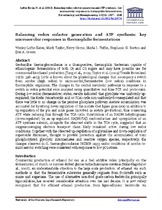Balancing redox cofactor generation and ATP synthesis: key microaerobic responses in thermophilic fermentations
Date
2013Author
Loftie-Eaton, Wesley
Taylor, Mark
Horne, Kerry
Tuffin, Marla I.
Burton, Stephanie G.
Cowan, Donald A.
Metadata
Show full item recordAbstract
Geobacillus thermoglucosidasius is a Grampositive, thermophilic bacterium capable of ethanologenic fermentation of both C5 and C6 sugars and may have possible use for commercial bioethanol production [Tang et al., 2009; Taylor et al. (2009) Trends Biotechnol 27(7): 398–405]. Little is known about the physiological changes that accompany a switch from aerobic (high redox) to microaerobic/fermentative (low redox) conditions in thermophilic organisms. The changes in the central metabolic pathways in response to a switch in redox potential were analyzed using quantitative real-time PCR and proteomics. During low redox (fermentative) states, results indicated that glycolysis was uniformly up-regulated, the Krebs (tricarboxylic acid or TCA) cycle non-uniformly downregulated and that there was little to no change in the pentose phosphate pathway. Acetate accumulation was accounted for by strong down-regulation of the acetate CoA ligase gene (acs) in addition to up-regulation of the pta and ackA genes (involved in acetate production), thus conserving ATP while reducing flux through the TCA cycle. Substitution of an NADH dehydrogenase (down-regulated) by an up-regulated NADH:FAD oxidoreductase and upregulation of an ATP synthase subunit, alongside the observed shifts in the TCA cycle, suggested that an oxygenscavenging electron transport chain likely remained active during low redox conditions. Together with the observed up-regulation of a glyoxalase and down-regulation of superoxide dismutase, thought to provide protection against the accumulation of toxic phosphorylated glycolytic intermediates and reactive oxygen species, respectively, the changes observed in G. thermoglucosidasius NCIMB 11955 under conditions of aerobic-to-microaerobic switching were consistent with responses to low pO2 stress.

